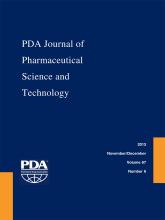Abstract
Leachable tungsten is associated with protein aggregation and precipitation in glass prefilled syringes, and this may trigger immunogenicity concerns. Determining the level of leachable tungsten from glass prefilled syringes is critical for assuring quality of certain biopharmaceutical drug products. An inductively coupled plasma mass spectrometry (ICP/MS) quantification method was developed to determine elemental tungsten in syringe extracts. The syringe was extracted using 0.5% ammonium hydroxide (pH 11), heat (75 °C), and sonication. The resulting extraction solution was diluted 10 fold prior to ICP/MS analysis. Syringes from three syringe lots containing known low (average 28.0 ng), medium (average 189.4 ng), and high (average 631.9 ng) levels of tungsten were extracted three times each. All syringes with total tungsten greater than 14 ng had extraction efficiency greater than 90% with the first two extractions combined. The calibration curve range was 0.1–200 μg/L tungsten with iridium as the internal standard, and the correlation coefficient was ≥1.0000. The limit of detection at 0.05 μg/L tungsten and limit of quantification at 0.1 μg/L tungsten were determined as having a signal-to-noise ratio greater than 40 and 80 times compared with the blank, respectively. The ICP/MS method was selective for tungsten and iridium in the presence of other metals. Accuracies of spiked tungsten, at three different levels, in syringe extracts were >99% with precision relative standard deviation (RSD) (n = 5) of ≤1%. The matrix effect of the syringe extract media and carryover of tungsten and internal standard were negligible. Onboard stability of the syringe extracts over three days had a tungsten concentration RSD (n = 3) of ≤1%. Syringe extractions performed with 0.45–0.55% ammonium hydroxide had spike recoveries ≥99% and demonstrated extraction solution robustness. Quantified residual tungsten in syringes extract by ammonium hydroxide and analyzed by ICP/MS was acceptable based on extraction efficiency and method performance.
LAY ABSTRACT: Elemental tungsten is a known leachable from glass prefilled syringe used as a ready-to-inject drug device in the pharmaceutical industry. Tungsten is a residual artifact from the manufacturing process of the syringe. The leachable tungsten level is of a concern, as it can affect the quality of the filled drug product. To understand possible leachable quantity of tungsten from the prefilled syringe, a tungsten extraction conditions and quantification method were developed. Double extraction of the syringe with 0.5% ammonium hydroxide (pH 11), heat (75 °C), and sonication was able to efficiently extract 90% of the total tungsten from syringe. An inductively coupled plasma mass spectrometry method was qualified to selectively, accurately, and precisely quantify the extracted tungsten. The developed extraction and quantification method was acceptable in determining possible leachable tungsten from prefilled syringes.
- © PDA, Inc. 2013
PDA members receive access to all articles published in the current year and previous volume year. Institutional subscribers received access to all content. Log in below to receive access to this article if you are either of these.
If you are neither or you are a PDA member trying to access an article outside of your membership license, then you must purchase access to this article (below). If you do not have a username or password for JPST, you will be required to create an account prior to purchasing.
Full issue PDFs are for PDA members only.
Note to pda.org users
The PDA and PDA bookstore websites (www.pda.org and www.pda.org/bookstore) are separate websites from the PDA JPST website. When you first join PDA, your initial UserID and Password are sent to HighWirePress to create your PDA JPST account. Subsequent UserrID and Password changes required at the PDA websites will not pass on to PDA JPST and vice versa. If you forget your PDA JPST UserID and/or Password, you can request help to retrieve UserID and reset Password below.






